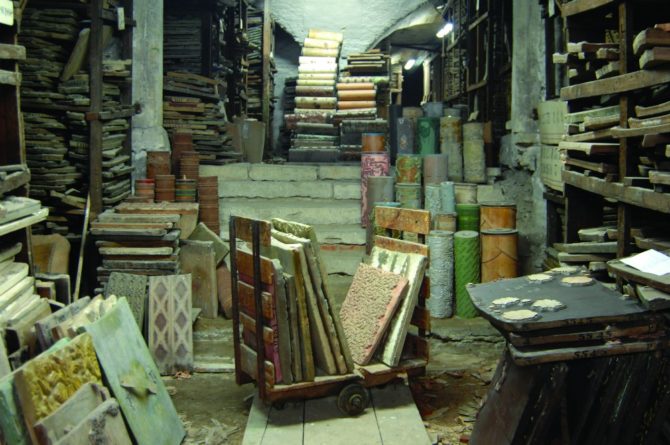Zuber: Wallpaper as Art

Valentine’s Day, 1962. A charming Jacqueline Kennedy leads her interviewer to the Diplomatic Reception Room, the first room of the restored Kennedy White House to be shown to the American public. Impressed, the interviewer focuses on the wallpaper, calling it “magnificent.” The camera pans the oval room to the First Lady’s soft, inimitable voiceover: “Yes, this is wallpaper that was printed in France about 1834, it’s all scenes of America, Niagara Falls… New York Harbour… Indians… West Point. I think the colours are marvellous.”
No need to take her word for it, even in black and white the drama and vitality of the scenes is unmistakable. The CBS documentary was a huge success. Broadcast in 106 countries, it won an Emmy award (which Ladybird Johnson accepted for the shy First Lady) and was a public- relations coup, winning Americans over to the captivating Jackie, whose project to transform a drab, characterless White House had provoked outrage in certain quarters, especially after the announcement that Mrs Kennedy had spent over $12,000 on French wallpaper.
The sophisticated 33-year-old First Lady was savvy enough to see that this was no ordinary wallpaper. It was one of the first printed panoramic scenes of Vues d’Amérique du Nord, an early design from Zuber, the world’s last –and one of its greatest – producers of luxury handmade wall coverings. Zuber came along at a time when wallpaper was indicative of one’s station in life.
Jean Zuber founded the company in 1797, a few years before the reign of Napoleon Bonaparte, in response to an explosion in the popularity of decorative papers for the interiors of bourgeois and aristocratic households in Europe and America. Although wallpaper in France dates back at least to the 15th century, it was only in the early 18th century that advances in printing techniques allowed for its mass production.
During the 17th-century craze for Chinoiserie, the first popular wall coverings were lavishly hand-decorated papers, created in China. The quality and beauty of the Chinese papers far outshone anything produced in France, wallpaper’s country of origin.
The earliest recorded wallpaper in Europe dates from 1481, when a manuscript painter named Jean Bourdichon created 50 rolls of hand- painted paper in sky blue, decorated with a host of angels and mounted on panels, for King Louis XI of France, who carted them around to his various castles to brighten up draughty rooms. However, the first printed wallpaper didn’t appear until the late 1500s. Records from the earliest paperhanger’s guild show that predominantly trompe l’oeil wood-grain or geometric designs were transferred on paper via a carved wooden block. More complicated floral or neoclassical designs were either outlined and stencilled onto paper or created with several blocks, each conveying a different coloured layer.
In the early 17th century, the French introduced flocked wallpaper, a process by which a background colour was applied to the paper, followed by an elaborately patterned adhesive which was then sprinkled with ‘flock’, the powdery by-product of wool and silk cloth manufacturing. Flock wallpaper’s velvety pile and repeating motif possessed an elegance reminiscent of prohibitively expensive tapestries and quickly became all the rage among the aristocracy. Madame de Pompadour papered her chambers at Versailles with flocked prints mounted on linen-covered panels – in those days paper wasn’t applied directly to the walls.
Towards Revolution
During the Renaissance, versions of wallpaper which prefigured the ‘modern’ product had appeared – that is, sheets of paper printed with contiguous designs and hung side-by-side, in order to create a mural effect. However, the first wallpaper as we know it didn’t show up until 1688, when a French engraver named Jean Papillon II used block prints to create repeating patterns on conjoined sheets of paper to form a roll, which was called papier de tapisserie.
It wasn’t until the 1750s that French wallpaper came into its own, when it was sought out by a prosperous merchant class that could afford it and was interested in interior design, as a way of expressing its new-found wealth. Jean-Baptiste Réveillon’s splendid printed and flocked wallpapers, already popular with an enthusiastic clientele among the nobility, received an extra boost when Marie Antoinette used them to decorate the Queen’s Apartments at Versailles – he was eventually granted the title Manufacture Royale.
Réveillon made a fortune, but on April 28 1789 a mob of workers, who were inflamed by an unfounded rumour that their already meagre wages were to be cut, set upon the wallpaper baron’s mansion in Paris’s Faubourg Saint Antoine. The workers set fire to Réveillon’s factory, which was sited on the ground floor of the mansion, and looted his private wine cellar.
Happily, Réveillon and his family escaped, but 25 people were killed at the hands of French troops in the mêlée, known as the Réveillon Riots. The actions of Réveillon’s workers, and the troops’ reaction, was the first violent conflict prior to the storming of the Bastille, which took place less than three months later.
Panoramic Scenes
Two important manufacturers to follow Réveillon were Joseph Dufour, based in the textile hub of Lyon, and Zuber in Rixheim, Alsace, both of which were founded in 1797.
At a time when taking the ‘Grand Tour’ was all the rage among young aristocrats, and seafaring expeditions mounted by the main European powers fired the public imagination, Joseph Dufour and Zuber began to produce richly coloured panoramic wallpapers of exotic scenes.
These innovative papers included the likes of Dufour’s designs featuring Captain Cook’s South Seas expeditions (1804-5) and Zuber’s Les Vues de Suisse (1804), L’Hindoustan (1807) and Les Vues d’Amérique du Nord (1843, mis-dated by Jacqueline Kennedy as 1834).
Dufour and Zuber also specialized in grisaille (entirely grey-scale) papers featuring mythological scenes and neoclassical motifs. These panoramas were printed using a painstaking process which involved hand painting an undercoat, applying multiple hand-carved woodblocks and stencilling the design’s outlines by hand with specially prepared gouache paint.
Dufour moved his thriving business to Paris, in the same neighbourhood where Réveillon met his downfall, and continued for another two decades. His death in 1827 saw the business shuttered forever.
Tradition in Action
Once one among many, Zuber is now the world’s last manufacturer making papier peints in the same building, using the methods it has continuously used for more than 200 years. A remarkable feat, considering what goes into a single panorama. There are 50 full murals produced at each printing and it takes two people several weeks to organize the 1,690 pearwood blocks required to hand-print each panorama.
Zuber possesses over 150,000 hand-carved woodblocks, which were made between 1797 and 1830, when the company employed 50 in-house woodcarvers, and each is classified as a national treasure. Once a block is worn out it is retired, along with its design, as the materials and expertise needed to recreate it is prohibitively expensive.
Next, it takes four people a month to hand brush a base dégradé surface – the rich graduated colour background characteristic of a Zuber mural. After that, it’s a balletic rhythm of building layer upon layer of overlapping designs and colours – about 2,030 unique paint formulas, to be exact – from formulas which are as old as the woodblocks.
Eight months later, the panorama – an edition of 50 murals made up of three to five scenes, each comprising six to eight panels, meaning all told there are anywhere from 18 to 40 panels – is ready for delivery. But to whom? At 16 metres-long and $45,000, this is no ordinary wallpaper.
Guillaume Tregouet, of Zuber’s London office – the company now has boutiques in Paris, London, New York, Dubai, Shanghai and Moscow – explains: “The panoramas are printed only as dictated by demand, and will go to individuals, institutions, fine hotels, etc. Once a specific panorama, like L’Hindoustan, one of our most popular themes, is sold out, there is a waiting list until the next printing.”
Alternatively, if waiting isn’t your style, there’s always Christie’s or Sotheby’s, where museum-worthy Zuber murals and scenes are frequently auctioned. The more ancient and rarely printed the paper, the more valuable – some have reached six figures. For those lacking the budget and the wall space, a few of the more popular sections can be purchased on their own.
More practical still, Zuber’s immense collection of gorgeous ornamental panels, standard wallpapers and borders – all of which are hand-printed and strictly made to order – are an investment more easily within reach.
Zuber’s hundreds of patterns in glorious colours represent 200 years of design and are an education in the history of French decorative arts. They include velvets, coloured stripes, florals and foliage, grisailles, even elaborate ceiling murals and custom-designed pressed Cordoba leather wall and floor coverings – a 24-carat-gold-embellished version of the latter was created for a private library. There are also elaborately embroidered upholstery and curtain fabrics, made in the traditional silk factories of Lyon.
Continual Innovation
Zuber remains the darling of high-end interior designers worldwide – French superstars Jacques Garcia and Berto Pinto are regular customers – but the company hasn’t rested on its laurels. With a dozen patents already under its belt, some dating back to the 19th century, Zuber continues to innovate, using its old woodblocks and copper plates to create consummately modern faux leathers which can be used on walls or floors and some exquisite silk-based wall coverings.
Zuber’s legacy is well documented in museums and notable homes throughout the United States (the President’s private dining room in the White House has another panorama) and France, and also features in some of the best hotels around the world, including the George V and Shangri-La in Paris.
Originally published in the February-March 2014 issue of France Today
Share to: Facebook Twitter LinkedIn Email
Leave a reply
Your email address will not be published. Required fields are marked *




REPLY
REPLY
REPLY